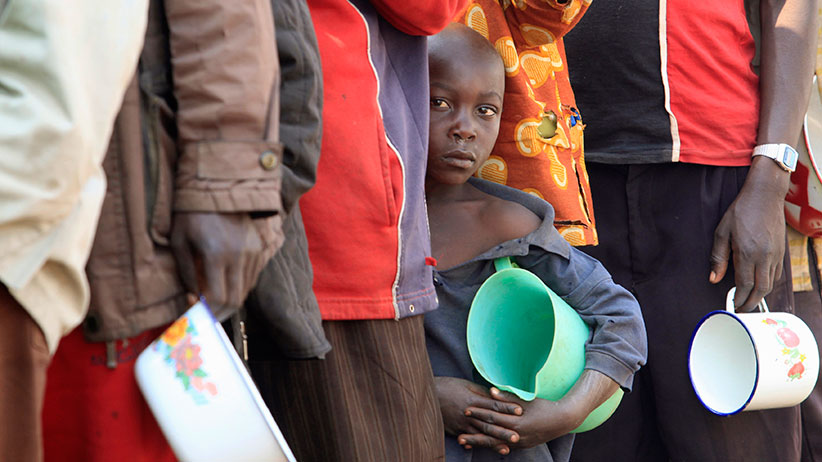A plan to save the world in 2015
The United Nations set eight ambitious goals for 2015 to dramatically improve global health and welfare. How close will it come to hitting its targets?
Congolese refugees queue for porridge at the Nyakabande refugee transit camp in Kisoro town, 521 km (324 miles) southwest of Uganda’s capital Kampala July 8, 2012. Rebels in eastern Democratic Republic of Congo said on Sunday they seized the town of Rutshuru in North Kivu province after government forces abandoned it. REUTERS/James Akena (UGANDA – Tags: CIVIL UNREST POLITICS FOOD SOCIETY TPX IMAGES OF THE DAY) – RTR34QG7
Share

When this millennium began, world leaders gathered at the United Nations in New York to pass the “Millennium Declaration”—a pledge to meet eight development goals by 2015. John McArthur, a senior fellow at the Brookings Institution, who worked on plans to achieve the millennium development goals (MDGs) as deputy director of the UN Millennium Project, says the initiative’s impact has been “enormous,” uniting governments, NGOs and the private sector around shared goals with measurable results. Progress has been particularly strong in sub-Saharan Africa, he says, and it lags in parts of the world suffering from conflict. According to Laurie Garrett, senior fellow for global health at the Council on Foreign Relations, these sorts of initiatives succeed at getting money out of donors’ pockets. But she says there are often problems sustaining results “without endless streams of foreign aid.” This puts recipient countries at the mercy of political will in donor countries, she adds. It can also mean that, because recipients have less control over designing strategy, those governments may feel disempowered and will not work to make programs sustainable with their own tax revenues. Below, Maclean’s takes a closer look at the UN’s eight MDGs and how we’ve done so far.
Eradicate extreme poverty and hunger
![]()
 |
One of the most daunting and important of the MDGs, there has been decent progress here—at least if one accepts that the headlined goal of “eradicating” extreme poverty and hunger was hyperbolic. The declaration, in fact, set a goal of halving, between 1990 and 2015, the number of people earning less than US$1.25 a day. That target was reached early, in 2010. A separate sub-goal would halve, between 1990 and 2015, the number of people suffering from hunger. The UN says this target should be “almost met” by 2015. A final criterion aimed to achieve “full and productive” employment for all, including women and young people. While wages have increased, the gender gap remains, and far fewer women have work than men. The Canadian government says it has put particular emphasis on agricultural development as a means of reducing global poverty. It has recently been criticized, however, for not spending millions of dollars that had been budgeted as aid for poor countries—instead returning it, unspent, to government coffers.
Achieve universal primary education
![]()
 |
The UN says the percentage of children in developing regions enrolled in primary education rose to 90 in 2010, up from 82 in 1999. According to Canada’s Department of Foreign Affairs, Trade and Development, this still left some 57 million children out of school in 2011. Girls face unique challenges, including poverty, the prevalence of early marriage and what the UN describes as “cultural and extremists attitudes.” Indeed, in places such as Nigeria, Afghanistan and Pakistan, Islamists have violently targeted girls attending school. In some places, girls have made big strides. During the years that the Taliban controlled Afghanistan, almost no girls attended school. Now, millions do. McArthur says while there has been a breakthrough in enrolment, it is only a first step. “Just getting kids in school doesn’t necessarily improve the learning outcomes,” he says. “We’re seeing kids going through school that are still barely able to read.” Post-2015, he says, the international community should focus on educational outcomes rather than school attendance.
Promote gender equality and empower women
![]()
 |
The UN claims that equality between girls and boys has been achieved in primary education, but notes that few countries have hit that target at all educational levels. Indeed, even at the primary level, it appears that equality exists—at best—in initial enrolment. The UN’s Educational, Scientific and Cultural Organization says 58 per cent of those who don’t complete primary school are young women, and almost a quarter of young women aged 15 to 24 have never completed primary school. Two-thirds of the 774 million illiterate people in the world are female, according to UNESCO. Women are increasingly participating in politics, but, throughout the developing world, they hold more vulnerable, lower-paying jobs. Poverty hits women hardest. Violence against women is widespread.
Reduce child mortality
![]()
 |
This goal has been a priority for Harper’s government, especially since launching the Muskoka Initiative at the 2010 G8 summit in Huntsville, Ont., at which members committed to spending billions of dollars on reducing child mortality and improving maternal health. The Department of Foreign Affairs pegs its contribution to maternal and child health programming between 2010 and 2015 at $2.85 billion. Global child mortality rates have dropped sharply in the last quarter-century—from 12.7 million children under the age of five dying in 1990, to 6.3 million in 2013, according to the UN. This figure falls short of the two-thirds millennium goal reduction, but it still means that some 17,000 fewer children are now dying each day. McArthur notes that not all of those averted deaths can be attributed to MDG initiatives; child mortality trends were significantly improving before the MDG project began. But he estimates that millions of children who would otherwise have perished survived as a result of MDG initiatives and funding.
Improve maternal health
![]()
 |
According to Garrett, if they were asked what is most important to them, women in much of the developing world would say: “that I don’t die in childbirth, and that I’m around to raise my children, and that I can have healthy children.” Yet programs to ensure safe pregnancies and childbirth get a fraction of the funding that combating HIV/AIDS does, she says. Still, global maternal mortality rates have dropped by almost half between 1990 and 2013, according to UN figures. In East and South Asia, and in North Africa, the rate has dropped by around two-thirds. These figures fall short of the UN’s 75 per cent reduction target. The UN blames, in part, insufficient health care access for women, and a lack of contraceptive use. McArthur says Prime Minister Stephen Harper’s commitment has provided leadership and helped to refine goals. But he says Canada also isn’t putting enough money where its mouth is. “It’s very modest. It’s much less than what Norway does in terms of its capacity. It’s nowhere near what Canada could be doing.”
Combat AIDS, malaria and other diseases
![]()
 |
In the last 10 or 15 years, HIV/AIDS transmission and mortality rates have decreased dramatically, helped in part by greater political will, and cheaper, more accessible health care. Garrett notes that a “full-package” one-year treatment now costs as little as $250. It used to cost $20,000. South Africa, a country whose population has been devastated by HIV/AIDS, can pay for primary care itself, she says. In countries with strong antipathy toward homosexuals, transmission rates are particularly high, because men are afraid or unable to get tested and to seek treatment. Despite the barriers, McArthur calls health a “clear-cut victory” among the MDGs. Governments now understand the importance of a population’s health to a region’s overall development. Tuberculosis rates are falling, though it remains a global killer. Malaria, which can be combated with the use of insecticide-treated mosquito bed nets, continues to ravage parts of the developing world, though with less ferocity now; mortality rates dropped 42 per cent between 2000 and 2012.
Environmental sustainability
![]()
 |
Attempts to meet this target have been the least successful, says McArthur. “Biodiversity, ecosystems management, oceans, desertification—all these basic elements of the environment are generally acknowledged to have not worked.” The UN notes that forests continue to disappear at an “alarming” rate, even if that rate is slower than it was during the 1990s. Carbon dioxide emissions are 50 per cent higher than they were during the 1990s, the UN says. While access to clean water has improved, according to the UN, about one billion people are still forced to defecate in the open, which, in turn, can threaten water supplies. Desertification can push groups competing over scarce grazing land into conflict. Garrett notes that inaccessible clean water even affects education. The farther a well is from a family’s home, the less likely young girls living there are to attend school. “Those little girls are spending all their days walking back and forth with giant jugs on their heads, and they never get in the classroom,” she says.
International aid and development
![]()
 |
The amount of money the world spent on international development aid dipped in 2012, a decline the Department of Foreign Affairs blames on the global financial crisis and the resulting austerity measures adopted by many Western countries. It has rebounded since, with the UN claiming a record high of US$135 billion spent in 2013. This MDG also recognizes that debt and trade barriers stifle growth in the developing world. About 80 per cent of imports to developed countries from developing ones enter duty-free, the UN says. The debt burden on developing countries has dropped substantially since 2000, but is now levelling off, according to the UN. Canada claims it has provided more than US$1 billion in debt relief since 2004. Internet penetration, a sub-target of this MDG, is growing rapidly in the developing world.